Puzzle Test | IBPS PO Prelims & Mains Preparation - Bank Exams PDF Download
Direction (1-5): Study the following information carefully and answer the questions given below.
Nine persons – L, M, N, O, P, Q, R, S and T are staying in a nine-storey building, but not necessarily in the same order. The lowermost floor is numbered as 1, the floor just above is numbered as 2 and so on.
P stays on an odd numbered floor but neither on the topmost floor nor on the lowermost floor. Only two persons stay between P and L. M stays two floors above L. Q stays immediately below M. As many floors between Q and R as between R and S. N stays above O. The number of floors above N is the same as the number of floors below O.
Q1: Who among the following stays on the fifth floor?
(a) The one who stays three floors below N
(b) S
(c) The one who stays immediately above R
(d) P
(e) None of these
Ans: (a)
Sol: 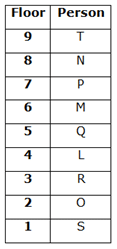
We have,
- P stays on an odd numbered floor but neither on the topmost floor nor on the lowermost floor.
- Only two persons stay between P and L.
- M stays two floors above L.
From the above conditions, there are three possibilities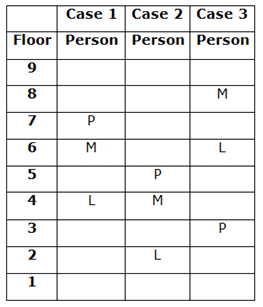
Again we have,
- Q stays immediately below M.
- As many floors between Q and R as between R and S.
Again we have,
- N stays above O.
- The number of floors above N is the same as the number of floors below O.
From the above conditions, case 2 and case 3 get eliminated. Hence, case 1 shows the final arrangement.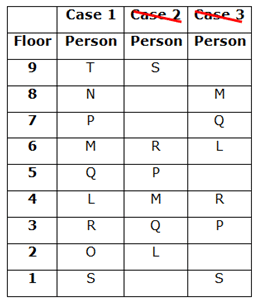
Q2: Which of the following statements is/are true with respect to the final arrangement?
(a) L stays on the fourth floor
(b) N stays three floors above Q
(c) R stays Above S
(d) All are true
(e) None of these
Ans: (d)
Sol: 
We have,
- P stays on an odd numbered floor but neither on the topmost floor nor on the lowermost floor.
- Only two persons stay between P and L.
- M stays two floors above L.
From the above conditions, there are three possibilities
Again we have,
- Q stays immediately below M.
- As many floors between Q and R as between R and S.
Again we have,
- N stays above O.
- The number of floors above N is the same as the number of floors below O.
From the above conditions, case 2 and case 3 get eliminated. Hence, case 1 shows the final arrangement.
Q3: Four of the following five are alike in a certain way as per the given arrangement and hence form a group. Find the one that doesn’t belong to that group.
(a) N-O
(b) P-R
(c) T-S
(d) M-L
(e) M-R
Ans: (e)
Sol: 
We have,
- P stays on an odd numbered floor but neither on the topmost floor nor on the lowermost floor.
- Only two persons stay between P and L.
- M stays two floors above L.
From the above conditions, there are three possibilities
Again we have,
- Q stays immediately below M.
- As many floors between Q and R as between R and S.
Again we have,
- N stays above O.
- The number of floors above N is the same as the number of floors below O.
From the above conditions, case 2 and case 3 get eliminated. Hence, case 1 shows the final arrangement.
Q4: How many persons are staying between T and O?
(a) Four
(b) Five
(c) Six
(d) Seven
(e) None of these
Ans: (c)
Sol: 
We have,
- P stays on an odd numbered floor but neither on the topmost floor nor on the lowermost floor.
- Only two persons stay between P and L.
- M stays two floors above L.
From the above conditions, there are three possibilities
Again we have,
- Q stays immediately below M.
- As many floors between Q and R as between R and S.
Again we have,
- N stays above O.
- The number of floors above N is the same as the number of floors below O.
From the above conditions, case 2 and case 3 get eliminated. Hence, case 1 shows the final arrangement.
Q5: As many persons stay between N and Q as between S and _____.
(a) Q
(b) R
(c) O
(d) M
(e) L
Ans: (e)
Sol: 
We have,
- P stays on an odd numbered floor but neither on the topmost floor nor on the lowermost floor.
- Only two persons stay between P and L.
- M stays two floors above L.
From the above conditions, there are three possibilities
Again we have,
- Q stays immediately below M.
- As many floors between Q and R as between R and S.
Again we have,
- N stays above O.
- The number of floors above N is the same as the number of floors below O.
From the above conditions, case 2 and case 3 get eliminated. Hence, case 1 shows the final arrangement.
Direction (6-10): Study the following information carefully and answer the questions given below.
Seven persons viz. M, N, O, P, Q, R and S are living in different floors of a seven-storey building such that the lowermost floor is numbered as 1, the floor immediately above it is numbered as 2 and so on till the topmost floor is numbered as 7. Each person is from different countries viz. China, India, Japan, Korea, Russia, Spain and USA. All the information is not necessarily in the same order.
O lives on an even-numbered floor and three floors below the one who is from Korea. P lives immediately below the one who is from Korea and two floors above the one who is from Japan. The number of floors above P is the same as the number of floors below the one who is from Russia. R lives three floors above the one who is from Russia, who lives immediately above M. The one who is from Spain lives immediately below the one who is from India and immediately above N. S is neither from Spain nor from USA.
Q6: Who among the following person is from Spain?
(a) Person who lives immediately below P
(b) R
(c) Person who lives on 6th floor
(d) S
(e) None of these
Ans: (c)
Sol: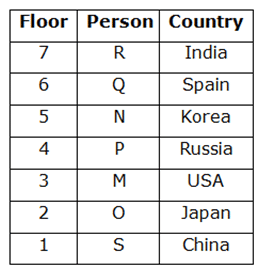
1. O lives on an even numbered floor and three floors below the one who is from Korea. P lives immediately below the one who is from Korea and two floors above the one who is from Japan.
From the above condition, there are two possibilities.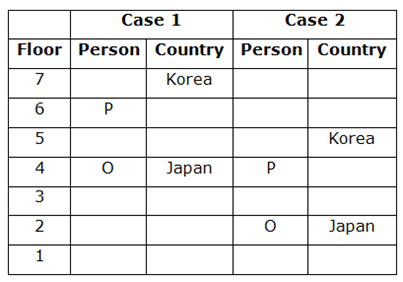
2. The number of floors above P is the same as the number of floors below the one who is from Russia. R lives three floors above the one who is from Russia, who lives immediately above M.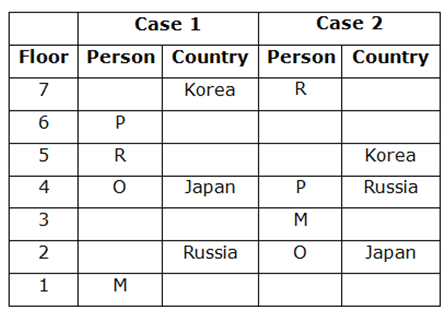
3. The one who is from Spain lives immediately below the one who is from India and immediately above N. S is neither from Spain nor from USA. Hence, case 1 gets eliminated. So Case2 shows the final arrangement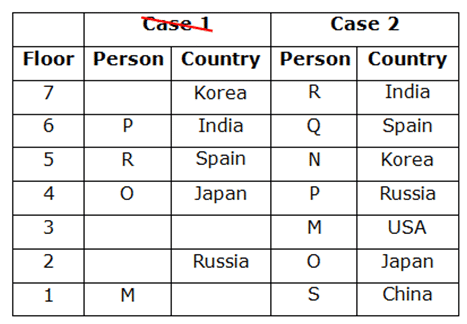
Q7: On which of the following floor does S live?
(a) Floor 6
(b) Floor 3
(c) Floor 4
(d) Floor 1
(e) None of these
Ans: (d)
Sol:
1. O lives on an even numbered floor and three floors below the one who is from Korea. P lives immediately below the one who is from Korea and two floors above the one who is from Japan.
From the above condition, there are two possibilities.
2. The number of floors above P is the same as the number of floors below the one who is from Russia. R lives three floors above the one who is from Russia, who lives immediately above M.
3. The one who is from Spain lives immediately below the one who is from India and immediately above N. S is neither from Spain nor from USA. Hence, case 1 gets eliminated. So Case2 shows the final arrangement
Q8: How many floors are there between N and the one who is from Japan?
(a) One
(b) As many floors are there between R and P
(c) Three
(d) More than three
(e) As many floors above the one who is from India
Ans: (b)
Sol:
1. O lives on an even numbered floor and three floors below the one who is from Korea. P lives immediately below the one who is from Korea and two floors above the one who is from Japan.
From the above condition, there are two possibilities.
2. The number of floors above P is the same as the number of floors below the one who is from Russia. R lives three floors above the one who is from Russia, who lives immediately above M.
3. The one who is from Spain lives immediately below the one who is from India and immediately above N. S is neither from Spain nor from USA. Hence, case 1 gets eliminated. So Case2 shows the final arrangement
Q9: If all the persons are living in alphabetical order from bottom to top, then how many persons remain unchanged in their position?
(a) One
(b) Two
(c) Three
(d) More than three
(e) None
Ans: (a)
Sol:
1. O lives on an even numbered floor and three floors below the one who is from Korea. P lives immediately below the one who is from Korea and two floors above the one who is from Japan.
From the above condition, there are two possibilities.
2. The number of floors above P is the same as the number of floors below the one who is from Russia. R lives three floors above the one who is from Russia, who lives immediately above M.
3. The one who is from Spain lives immediately below the one who is from India and immediately above N. S is neither from Spain nor from USA. Hence, case 1 gets eliminated. So Case2 shows the final arrangement
Q10: M is from which of the following country?
(a) China
(b) India
(c) Korea
(d) USA
(e) None of these
Ans: (d)
Sol:
1. O lives on an even numbered floor and three floors below the one who is from Korea. P lives immediately below the one who is from Korea and two floors above the one who is from Japan.
From the above condition, there are two possibilities.
2. The number of floors above P is the same as the number of floors below the one who is from Russia. R lives three floors above the one who is from Russia, who lives immediately above M.
3. The one who is from Spain lives immediately below the one who is from India and immediately above N. S is neither from Spain nor from USA. Hence, case 1 gets eliminated. So Case2 shows the final arrangement
|
647 videos|1000 docs|305 tests
|
FAQs on Puzzle Test - IBPS PO Prelims & Mains Preparation - Bank Exams
| 1. What are the eligibility criteria for the Puzzle Test? |  |
| 2. How can I register for the Puzzle Test? |  |
| 3. What is the format of the Puzzle Test? |  |
| 4. How can I prepare for the Puzzle Test effectively? |  |
| 5. How can I access my Puzzle Test results? |  |

















